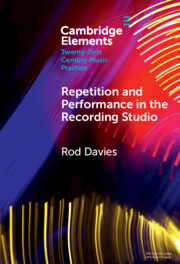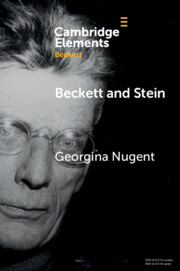52 results
2 - Liturgical Experience
-
- Book:
- Ways of Living Religion
- Published online:
- 07 March 2024
- Print publication:
- 14 March 2024, pp 56-89
-
- Chapter
- Export citation

Repetition and Performance in the Recording Studio
-
- Published online:
- 12 February 2024
- Print publication:
- 14 March 2024
-
- Element
- Export citation
8 - Revision and Examination Techniques
-
- Book:
- Cognitive and Emotional Study Strategies for Students with Dyslexia in Higher Education
- Published online:
- 14 September 2023
- Print publication:
- 28 September 2023, pp 275-318
-
- Chapter
- Export citation
Chapter 4 - Cultural Composition, Insistent Spirals, and Definition by Contrast
-
- Book:
- Cybernetic Aesthetics
- Published online:
- 10 October 2023
- Print publication:
- 28 September 2023, pp 106-140
-
- Chapter
- Export citation
7 - Repetition and reduplication in Italian
- from Romance
-
-
- Book:
- Expressivity in European Languages
- Published online:
- 24 August 2023
- Print publication:
- 07 September 2023, pp 231-268
-
- Chapter
- Export citation
Chapter 8 - The Love Letter
-
- Book:
- Phenomenology of the Icon
- Published online:
- 17 August 2023
- Print publication:
- 31 August 2023, pp 246-271
-
- Chapter
- Export citation
Chapter 16 - Repetition in the Fragmentary Orators
- from Part III - Other Genres and Fragmentary Authors
-
-
- Book:
- Early Latin
- Published online:
- 27 July 2023
- Print publication:
- 17 August 2023, pp 327-350
-
- Chapter
- Export citation
Chapter IV - Time For Allusion
-
- Book:
- Markers of Allusion in Archaic Greek Poetry
- Published online:
- 11 May 2023
- Print publication:
- 25 May 2023, pp 244-327
-
- Chapter
-
- You have access
- Open access
- HTML
- Export citation

Beckett and Stein
-
- Published online:
- 01 May 2023
- Print publication:
- 25 May 2023
-
- Element
- Export citation
1 - The Lyric Impulse: Musicological and Methodological Contexts
- from Part I - Contexts
-
- Book:
- Schubert's String Quartets
- Published online:
- 13 April 2023
- Print publication:
- 20 April 2023, pp 19-64
-
- Chapter
- Export citation
Intonation correlates of canonical and non-canonical wh-in-situ questions in Spanish
-
- Journal:
- Journal of Linguistics / Volume 60 / Issue 1 / February 2024
- Published online by Cambridge University Press:
- 16 January 2023, pp. 29-50
- Print publication:
- February 2024
-
- Article
-
- You have access
- Open access
- HTML
- Export citation
Inverted U-shaped model: How frequent repetition affects perceived risk
-
- Journal:
- Judgment and Decision Making / Volume 10 / Issue 3 / May 2015
- Published online by Cambridge University Press:
- 01 January 2023, pp. 219-224
-
- Article
-
- You have access
- Open access
- HTML
- Export citation
4 - A Double-Edged Sword
- from Part I - Industry
-
-
- Book:
- Whose Country Music?
- Published online:
- 03 February 2023
- Print publication:
- 01 December 2022, pp 55-70
-
- Chapter
- Export citation
Epilogue
-
- Book:
- <i>Carpe Diem</i>
- Published online:
- 18 November 2022
- Print publication:
- 01 December 2022, pp 227-238
-
- Chapter
-
- You have access
- Open access
- HTML
- Export citation
Language performance as a prognostic factor for developing Alzheimer’s clinical syndrome and mild cognitive impairment: Results from the population-based HELIAD cohort
-
- Journal:
- Journal of the International Neuropsychological Society / Volume 29 / Issue 5 / June 2023
- Published online by Cambridge University Press:
- 21 October 2022, pp. 450-458
-
- Article
-
- You have access
- Open access
- HTML
- Export citation
7 - (Mis/Non)Understanding in Intercultural Interactions
- from Part II - Key Issues in Intercultural Pragmatics Research
-
-
- Book:
- The Cambridge Handbook of Intercultural Pragmatics
- Published online:
- 29 September 2022
- Print publication:
- 20 October 2022, pp 164-186
-
- Chapter
- Export citation
Chapter Six - Repetition and Replication: Laying the Groundwork for an Empirical Study
-
- Book:
- Fundamental Principles of Corpus Linguistics
- Published online:
- 22 September 2022
- Print publication:
- 29 September 2022, pp 184-216
-
- Chapter
- Export citation
9 - The Dynamics of Repetition
- from Part III - Innovative Concepts
-
-
- Book:
- Conceptualizing International Practices
- Published online:
- 09 June 2022
- Print publication:
- 23 June 2022, pp 193-212
-
- Chapter
- Export citation
3 - Teaching vocabulary and the roles of the teacher
-
- Book:
- Learning Vocabulary in Another Language
- Published online:
- 02 June 2022
- Print publication:
- 09 June 2022, pp 93-155
-
- Chapter
- Export citation
4 - Remembering Refrains
-
- Book:
- Devotional Refrains in Medieval Latin Song
- Published online:
- 24 March 2022
- Print publication:
- 31 March 2022, pp 148-189
-
- Chapter
- Export citation



